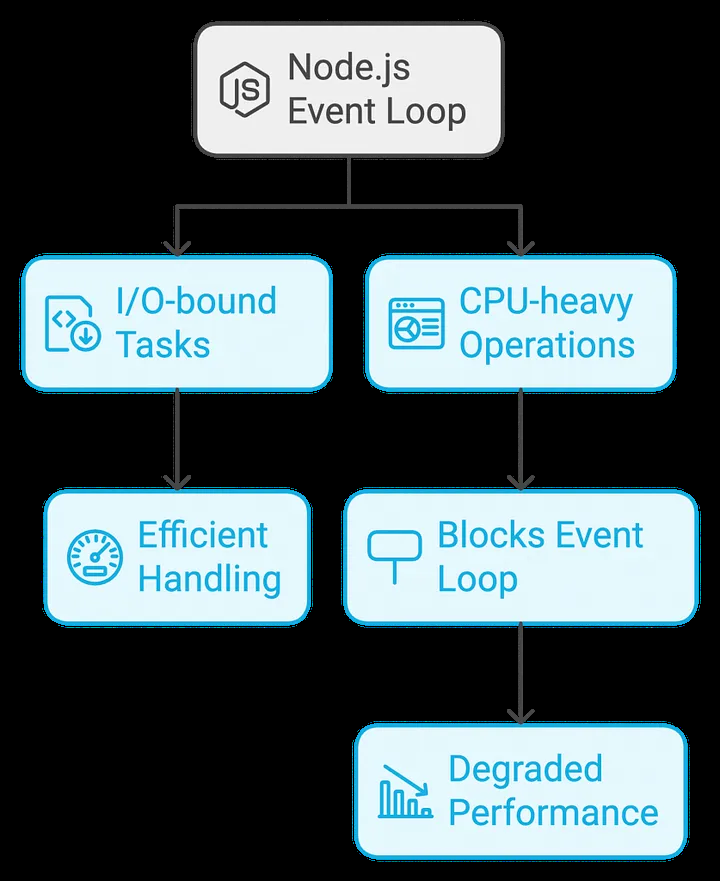Home >Web Front-end >JS Tutorial >Mastering Node.js Performance: Unlock the Power of Worker Threads and Clustering — Hoai Nho
Mastering Node.js Performance: Unlock the Power of Worker Threads and Clustering — Hoai Nho
- Barbara StreisandOriginal
- 2024-10-21 16:40:02958browse
Node.js is known for being single-threaded, leveraging the event loop to handle asynchronous operations efficiently. However, handling CPU-intensive tasks or utilizing multiple CPU cores requires more advanced approaches: Worker Threads and Clustering. This article dives deep into these techniques, providing clear explanations and practical code examples that you can directly use.

1. Overview: Why Use Worker Threads and Clustering?
- Worker Threads: Run CPU-intensive code in parallel without blocking the event loop.
- Clustering: Scale an application by spawning multiple instances (processes) to utilize multiple CPU cores.

Both techniques address scalability and performance, but they differ:
- Worker Threads: Best for heavy computation within a single process.
- Cluster: Best for handling high traffic by spawning multiple processes to distribute load.
2. Event Loop and the Need for Multi-threading
The event loop in Node.js is single-threaded. While it works great for I/O-bound tasks, it struggles with CPU-heavy operations like image processing, encryption, or complex calculations. Without multi-threading, these operations block the event loop, affecting performance.

3. Worker Threads in Node.js

Worker Threads allow us to execute JavaScript code on multiple threads, preventing the main thread from being blocked.
Example: Image Compression using Worker Threads
This example demonstrates how to use Worker Threads to compress images without blocking the main event loop.
Step 1: Install sharp for image processing.
npm install sharp
Step 2: Create image-worker.js (worker code).
npm install sharp
Step 3: Main thread using Worker from worker_threads.
const { parentPort, workerData } = require('worker_threads');
const sharp = require('sharp');
// Compress the image
sharp(workerData.inputPath)
.resize(800, 600)
.toFile(workerData.outputPath)
.then(() => parentPort.postMessage('Compression complete'))
.catch(err => parentPort.postMessage(`Error: ${err.message}`));
How It Works
- The main thread offloads the image compression task to a Worker Thread.
- The event loop remains free to handle other tasks.
- When the worker completes, it sends a message back to the main thread.
4. Clustering in Node.js
Clustering involves spawning multiple instances of a Node.js process, utilizing all available CPU cores. This is especially useful in high-traffic web servers.

Example: Simple HTTP Server Using Cluster
This example shows how to use the cluster module to create a scalable HTTP server.
const { Worker } = require('worker_threads');
const path = require('path');
function compressImage(inputPath, outputPath) {
return new Promise((resolve, reject) => {
const worker = new Worker(path.resolve(__dirname, 'image-worker.js'), {
workerData: { inputPath, outputPath }
});
worker.on('message', message => resolve(message));
worker.on('error', reject);
worker.on('exit', code => {
if (code !== 0) reject(new Error(`Worker stopped with exit code ${code}`));
});
});
}
// Example usage
compressImage('input.jpg', 'output.jpg')
.then(console.log)
.catch(console.error);
How It Works
- Primary process forks child processes (workers) based on the number of CPU cores.
- Workers share the same port (in this case, 3000) to handle incoming requests.
- If a worker crashes, the cluster module restarts it automatically, ensuring reliability.
5. Communication Between Worker Threads or Clusters
Worker Communication (Pub/Sub Pattern)
Workers and the main thread communicate via message passing—similar to the Pub/Sub model. In the image compression example above, the worker thread sends status updates to the main thread using parentPort.postMessage().

You can use Redis Pub/Sub or Message Queues (like RabbitMQ) for more advanced communication between clusters or threads.
6. When to Use Worker Threads vs Clustering?
| Aspect | Worker Threads | Clustering |
|---|---|---|
| Use case | CPU-intensive tasks | High-traffic applications |
| Execution | Runs within a single process | Spawns multiple processes |
| Performance | Avoids blocking the event loop | Utilizes multiple CPU cores |
| Communication | Message passing between threads | Message passing between processes |
| Fault Tolerance | Limited to process-level recovery | Can restart individual processes |

Examples of Usage
- Worker Threads: Image compression, data encryption, machine learning model inference.
- Clustering: Load-balanced HTTP servers, APIs handling thousands of requests per second.
7. Best Practices for Using Workers and Clusters

- Graceful shutdown: Ensure workers or clusters exit gracefully to prevent data loss.
- Health checks: Monitor worker processes and restart them automatically if they crash.
- Resource management: Limit memory and CPU usage to prevent workers from overwhelming the system.
- Communication strategies: Use Redis or NATS for advanced message passing between clusters.
8. Conclusion
Both Worker Threads and Clustering are powerful tools to improve performance and scalability in Node.js applications. Worker Threads are best suited for CPU-bound tasks without blocking the event loop, while Clustering allows you to scale web servers horizontally across multiple CPU cores.
By understanding the differences and choosing the right approach for your use case, you can significantly enhance your application’s throughput and resilience.
The above is the detailed content of Mastering Node.js Performance: Unlock the Power of Worker Threads and Clustering — Hoai Nho. For more information, please follow other related articles on the PHP Chinese website!
Related articles
See more- An in-depth analysis of the Bootstrap list group component
- Detailed explanation of JavaScript function currying
- Complete example of JS password generation and strength detection (with demo source code download)
- Angularjs integrates WeChat UI (weui)
- How to quickly switch between Traditional Chinese and Simplified Chinese with JavaScript and the trick for websites to support switching between Simplified and Traditional Chinese_javascript skills

